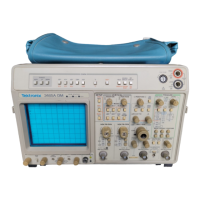
Do you have a question about the Tektronix 2465A and is the answer not in the manual?
| Type | Oscilloscope |
|---|---|
| Bandwidth | 400 MHz |
| Channels | 4 |
| Vertical Sensitivity | 2 mV/div to 5 V/div |
| Input Impedance | 1 MΩ ± 2% |
| Trigger Modes | Auto, Single |
| Display | CRT |
| Power Requirements | 48-440 Hz |
Safety precautions, line voltage, and fuse selection for initial instrument setup.
Details on power cord connection, instrument cooling, start-up, and repackaging for shipment.
Explains fundamentals, getting a display, and characteristics of the AUTO Setup feature.
Covers vertical controls, input coupling modes, and video signal conditioning.
Details channel selection, ADD/INVERT, CHOP/ALT modes, and 20 MHz BW Limit.
Introduces horizontal sweep controls and fundamental trigger control settings.
Explains trigger modes, sources, and coupling options for stable triggering.
Covers trigger level, holdoff adjustment, and setup for video triggering.
Guides on triggering at specific video lines and comparing synchronized video signals.
Explains readout display features, trigger readout, and intensity controls.
Introduces cursor measurements for voltage, time, frequency, ratios, and phase.
Details measuring frequency, ratios, and using delta modes with cursors.
Covers probe connections, fidelity, grounding, and compensation checks.
Guides on using Delayed Sweep to magnify waveform details for analysis.
Explains B-Trigger operation, mode distinctions, and setup procedures.
Describes using delayed sweeps for accurate time interval measurements.
Covers precision timing, direct/indirect measurements, and condition messages.
Details measuring intervals using B-Sweep delays and B Trigger modes.
Provides steps to measure a time interval defined by the B Trigger.
Explains choosing time-interval resolution and measurement update rates.
Details performing frequency, period, and totalize counting measurements.
Covers totalizing events, delay sweeps, and cancelling menu functions.
Guides on initiating sweeps using event counts with the CTT menu.
Details changing event counts and modifying trigger settings.
Discusses avoiding ambiguous counts and cancelling menu functions.
Explains logic triggering and initiating sweeps using CTT and WR.
Summarizes sweep triggering and details Word Recognizer operation.
Covers saving, recalling, and managing instrument setups and sequences.
Guides on recalling sequences and explains the STEP indicator function.
Describes measuring peak-to-peak and absolute voltage levels using cursors.
Covers noise immunity, DC voltage estimation, and amplitude modulation measurements.
Details frequency modulation measurements and video signal analysis in IRE units.
Explains avoiding false displays and using algebraic addition for interference analysis.
Covers observing digital signal coincidence and cancelling interference.
Guides on measuring period/frequency and eliminating common-mode signals.
Details measuring rise time, fall time, and time between pulses.
Explains measuring slew rate and time ratio (duty factor).
Covers measuring phase difference and low millivolt signals.
Illustrates phase difference measurements with different display scales.
Covers initial setup procedure and trace rotation adjustment for optimal display.
Details astigmatism adjustment for beam shape and the auto DC balance routine.
Provides instructions for checking and adjusting probe compensation for accuracy.
Guides on matching Channel 2 delay to eliminate probe-introduced differences.
Outlines procedures for checking amplitude and timing accuracy.
Describes power, display, setup, and vertical controls including STEP/AUTO and SAVE/RECALL.
Details controls for CH 1/2, including BW Limit, VOLTS/DIV, Input Coupling, and VAR.
Covers CH 3/4 inputs, position controls, VOLTS/DIV, CALIBRATOR, and ground jack.
Describes horizontal sweep controls and basic trigger controls.
Explains horizontal modes, delay/delta controls, trigger modes, sources, and coupling.
Details rear panel connectors like GPIB, probe power, gate outputs, and switches.
Introduces DMM controls for voltage, current, resistance, continuity, and temperature.
Details environmental and operational conditions for valid electrical characteristic specifications.
Lists electrical characteristics for vertical deflection systems, including bandwidth and accuracy.
Provides specifications for sweep time base ranges, accuracy, and jitter.
Covers X-Y operation characteristics, cursor ranges, and graticule details.
Lists Z-Axis input sensitivity and signal output specifications.
Details AC power source voltage, frequency, fuse rating, and consumption.
Lists detailed electrical characteristics for the DMM option across various functions.
Provides electrical characteristics for the TV option, including video signal handling.
Details C/T/T option characteristics for frequency, period, counting, and timing.
Lists electrical characteristics for the Word Recognizer option.
Provides electrical characteristics for the GPIB option.
Details mechanical specifications including weight, dimensions, and construction.
Lists environmental requirements for temperature, altitude, humidity, shock, and EMI.
Describes instrument options and accessories available.
Details Option 11 for probe power and Option 1R for rackmounting.
Lists international power cord options with part numbers.
Lists standard accessories provided with each instrument and specific options.
Recommends optional accessories such as protective covers and service manuals.
Explains diagnostic exercisers for controlling setup modes, logging, and transferring setups.
Details GPIB address programming and message terminator/talk-listen settings.
Covers setup transfer modes and TV system/line numbering selection.
Explains TV sync polarity defaults and DMM continuity/resistance exerciser.
Explains organizing and sequentially recalling stored setups using the STEP/AUTO button.
Details REPLACE, INSERT, and DELETE modes for editing setup sequences.
Guides on executing stored sequences and accessing help messages.
Explains power-up tests ensuring instrument operational confidence.
Lists confidence test numbers and the functions affected by failures.
Presents graphs of Delta-Time and Delta-Delay-Time accuracy for C/T/T Option.
Shows graphs illustrating Delay-Time accuracy for C/T/T Option.
